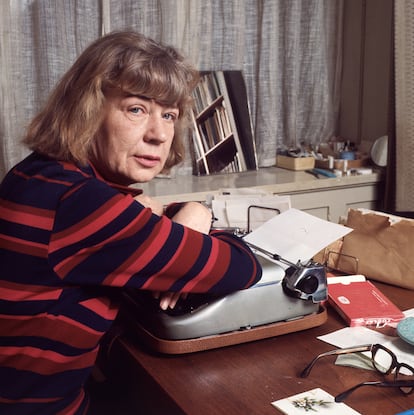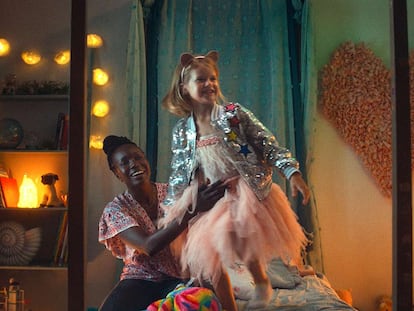‘No one is listening to me’: A fictional journey into the minds of alienated, married women
Books, series and movies have updated the alienated archetype of ‘Jane Eyre’ to rage against power imbalances and the frustrations caused by marriage


Copenhagen, 1968: a writer who prefers to think that her husband’s infidelities “are a provocation, like when children play with porridge,” falls into the abyss. During her medical confinement, she is tormented by the faces and voices of others.
Boston, 1892: a woman diagnosed with nervous depression “with a slight tendency to hysteria” is confined by her husband in a room and ends up going crazy, peeling the yellow wallpaper with her fingernails.
Tuscany, 1561: At 16 years old, the perceptive Lucrezia de Medici lives in a delusional state of terror, convinced that her new husband wants to murder her in the wild and lonely fortress in which she is forced to live.
There is an invisible thread that unites these plots, which belong to The Faces, a novel by the Danish author Tove Ditlevsen; The Yellow Wallpaper, a short story by American writer Charlotte Perkins and The Marriage Portrait, a novel by Maggie O’Farrell. All the protagonists of these works are married women, who—while appearing happy in the eyes of others—end up collapsing into a paranoia caused by the oppression of marriage. Through their heroines, whose judgement has been suspended by their alienation, the authors allow readers to contemplate the power imbalances of the institution of family.
Like Bertha Mason—that cursed character isolated in a house used by Charlotte Brontë in Jane Eyre—it could be said that these fictional women update the archetype of the “madwoman in the attic.” A new twist on the concept, which was analyzed by academics Sandra Gilbert and Susan Gubar in the 1970s, through a well-known essay on the possibilities of female imagination in 19th-century literature.
This archetype was explored through the fiction of Jane Austen, the Brontës, Mary Shelley and Emily Dickinson, works in which a supposedly deranged woman had the objective of exposing the duality and struggle between the angelic wife and the crazy one. Dominican-British author Jean Rhys would also resort to this in her novel Wide Sargasso Sea (1966)—which was received as a sort of prequel to Jane Eyre—as did Janet Frame with An Angel at my Table (1984). These works conveyed hysterical women being cornered, in an interrogation of the power imbalances within marriages and families.
Married women who are not safe
In The Faces—the 1968 novel that Ditlevsen published a few years before her Copenhagen Trilogy and her suicide—Lise Mundus is a writer of children’s books who has just become famous after receiving an award. Afterward, however, she experiences an episode of extreme alienation that ultimately sees her end up in a hospital bed. She feels that fame has removed “with brutal force the veil that had kept her from reality”—she hears voices and is tormented by the faces of others.
As the newspapers harass her to write about “whether the miniskirt is going to kill marriage,” she thinks that her husband, Gert, is having an affair with their domestic worker, Gitte. And that he is doing all of this after Grete—his former lover—took her own life. She’s convinced that Gitte is giving her sleeping pills, so as to also guide her towards suicide.
If in The Faces Lise clings to the master bedroom because it provides her with “the fragile security provided by the absence of change,” in The Married Portrait—released last year—Maggie O’Farrell’s audacious protagonist is afraid to embrace her husband or be left alone with him, because she is convinced that he wants to kill her. Her husband is the Duke Of Ferrara—12 years her senior—by way of a marriage that her father arranged out of obligation. The Duke was previously engaged to her older sister, who died suddenly during the preparations for the wedding banquet. The protagonist doesn’t understand why he insists on isolating her in a fortress “for the sake of rest and a change of scenery.”
It’s not surprising that O’Farrell opted for such a plot. The Irish writer penned the preface for the new edition of The Yellow Wallpaper, a short story that feminist pioneer Charlotte Perkins Gilman published in 1892, in an act of revenge against the doctor who forbade her to write because of her postpartum depression.
The story revolves around a nameless young woman who spends a summer in a mansion in the countryside. She goes mad there, as she is confined to a room by her husband.
“For centuries, writers have been using the trope of the ‘mad woman’—usually in a secondary way,” O’Farrell writes in her introduction. “What Yellow Wallpaper does is provide the crazy woman with a pencil and paper and, ultimately, with her own voice [...] The only thing we can do is listen,” she notes, possibly anticipating part of what she has done in her latest novel.

Worry, my dear
Literary critic Phyllis Rose explains that marriage “is such an important political issue that it should be taken as seriously as debating national elections.” This is how she puts it in Parallel Lives, a juicy essay on how “human beings tend to resort to love whenever they want to camouflage transactions that imply power.”
In the essay, Rose delves into five famous Victorian-era weddings. From John Stuart Mill—a prominent defender of equality—to the marriage of writer John Ruskin and Effie Gray, whom he drove out of her mind and left a virgin. She filed for divorce after a medical analysis, which checked to see if her body suffered from a maladjustment that provoked this carnal rejection (there wasn’t any).
“Every marriage is a subjective fiction, with two points of view often in conflict, and sometimes, fortuitously, working in unison,” Rose writes in her foreword.
Curiously, this theory is fully in line with the one established by Fleishman is in Trouble, the Disney+ series that adapts the novel by journalist Taffy Brodesser-Akner. While the plot initially seems focused on empathizing with the life of the male protagonist, Toby—a doctor who is portrayed by Jesse Eisenberg—everything suddenly changes near the end, when the viewers discover the perspective of his ex-wife, Rachel (portrayed by Claire Danes).

As already happened with the praise that Florence Pugh received for her role in Don’t Worry, Darling—a dystopic film about a reactionary movement that calls for the return of the traditional housewife—Claire Danes has been cheered for her performance. However, many critics have taken issue with the former star of Homeland—they appear to be exhausted with her new role, which has been heavily associated with the privileged women of New York, who are obsessed with protecting their status.
In Fleishman, what initially seems like a selfish, maternal disconnect actually turns out to be a portrait of how female self-demand can lead to psychosis or a severe anxiety crisis. One so sharp that it makes the protagonist hallucinate and isolate herself in her Upper East Side home.
Rachel’s crisis is narrated through another deranged woman named Libby, although this character is seen as “functional” in the eyes of others. Close to Toby and played by Lizzy Caplan, the voice that narrates the series is a journalist for a men’s magazine who has thrown in the towel due to the lack of recognition she has received for her work. This narrator is resigned to her fate, trapped in suburban New Jersey. Yet, she longs for the bustle of Manhattan, especially after having quit her job to focus on her role as a wife and mother. Her new life isn’t going so well—but it’s the easiest choice. In one episode, she tells the audience: “Now that I stay at home, I can say that out loud. But since I no longer work, no one is listening to me.”
Sign up for our weekly newsletter to get more English-language news coverage from EL PAÍS USA Edition
Tu suscripción se está usando en otro dispositivo
¿Quieres añadir otro usuario a tu suscripción?
Si continúas leyendo en este dispositivo, no se podrá leer en el otro.
FlechaTu suscripción se está usando en otro dispositivo y solo puedes acceder a EL PAÍS desde un dispositivo a la vez.
Si quieres compartir tu cuenta, cambia tu suscripción a la modalidad Premium, así podrás añadir otro usuario. Cada uno accederá con su propia cuenta de email, lo que os permitirá personalizar vuestra experiencia en EL PAÍS.
¿Tienes una suscripción de empresa? Accede aquí para contratar más cuentas.
En el caso de no saber quién está usando tu cuenta, te recomendamos cambiar tu contraseña aquí.
Si decides continuar compartiendo tu cuenta, este mensaje se mostrará en tu dispositivo y en el de la otra persona que está usando tu cuenta de forma indefinida, afectando a tu experiencia de lectura. Puedes consultar aquí los términos y condiciones de la suscripción digital.
More information
Archived In
Últimas noticias
Most viewed
- Sinaloa Cartel war is taking its toll on Los Chapitos
- Oona Chaplin: ‘I told James Cameron that I was living in a treehouse and starting a permaculture project with a friend’
- Reinhard Genzel, Nobel laureate in physics: ‘One-minute videos will never give you the truth’
- Why the price of coffee has skyrocketed: from Brazilian plantations to specialty coffee houses
- Silver prices are going crazy: This is what’s fueling the rally










































